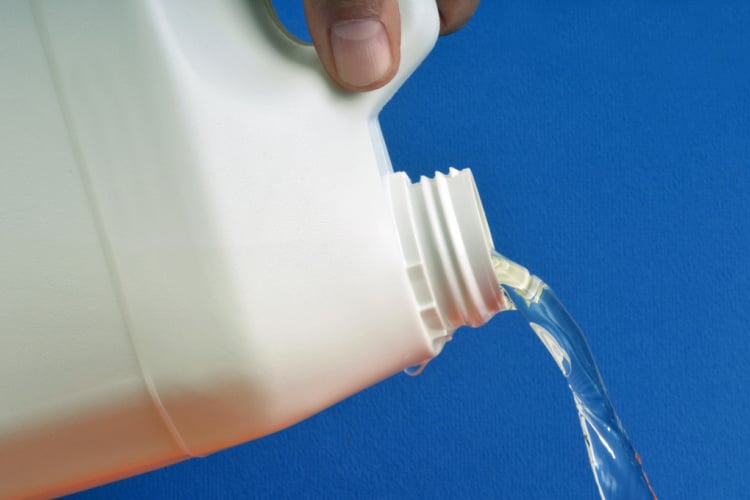Yes, you can use bleach to clean a water softener brine tank depending on the manufacturer’s instruction. Some manufacturers, like Whirlpool, allow using bleach to clean the system. Use between ¾ oz – 5 oz of bleach depending on the size of your water softener.
If there’s no information in the instruction manual pertaining to the use of bleach in the device, you should contact the manufacturer’s customer service for confirmation before proceeding.
Bleach is one of the first disinfectants that comes to mind when you want to eliminate malodors and pathogens like bacteria and viruses, especially in water treatment, but it’s also a harsh chemical. So, unless specified by the manufacturer, putting it in a water softener device can cause the system to malfunction.

Some water softener resins may chemically react to the chemicals in bleach, thus losing their ion-exchange properties and eventually rendering the device ineffective. Even when the manufacturer allows bleach usage, you should be careful not to overdo it.
The recommended dosage for small water softener units (1 – 3 bathrooms) is ¾ oz of bleach, while 4 – 6 bathroom and 7+ bathrooms water softener systems should use 1.5 oz and 5 oz of bleach respectively.
If you don’t want to use bleach, the other option is to clean the water softener with vinegar.
How to Sanitize Water Softener with Bleach
There are 2 ways to sanitize a water softener system with bleach:
The first option is to manually clean the brine tank (the tank where the salt goes) with a bleach solution. The second option is to run a bleach cycle.
1. How to Manually Clean the Brine Tank With Bleach:
- Turn off the water softener system. If you still need running water in the house, you don’t need to turn off all the incoming water. You can just bypass the water softener.
- Empty the brine tank. If there’s any liquid (brine solution) inside the brine tank, empty it and remove the salt from the tank. If you suspect the brine tank is infected with bacteria, dump the salt in a trash bin. (Note: The brine tank is the smaller tank of the system.)
- Clean the tank with a soft utensil. Scrub the inside of the tank with warm water and soap until there’s no trace of brine, salt, or however unlikely, sediment. Use a soft brush or sponge during this procedure because you don’t want to damage the tank or its parts.
- Wash the tank with a bleach solution. Make a solution using scentless bleach that has no additives, and wash the tank thoroughly with it. Then, rinse the tank with clean water until there’s no bleach remaining. (Note: Since you’re going to rinse it, it doesn’t matter how much bleach you use, but still, you shouldn’t overdo it. A medium bleach solution, 20mL (4 tablespoons) of bleach per 1L (4 cups) of water, should suffice.)
- Put new salt into the tank.
- Make another bleach solution. First, pour 3 to 4 gallons of clean water into the brine tank. Then, make another solution by adding bleach to it. It’s important how much bleach you put into this solution since it’s going to be used to wash the whole system during the regeneration process. So, mix it in ¾ oz for small units, 1.5 oz for medium units, and 5 oz for large units. When the device regenerates automatically, it’ll use this bleached brine solution to recharge and clean the resin, and in the end, you’ll have a disinfected water-softening system.
Important note: Don’t use soft water during the pre-programmed regeneration process, and after the regen, make sure to run a soft water faucet for a while to ensure the bleach leaves the system.
Here are several how-to videos on sanitizing water softener with bleach:
2. How to Run a Bleach Cycle
You can simply run a bleach cycle if you don’t want to manually clean the water softener. Here’s how to do it:
- Determine how much bleach you need. Depending on the size of your water-softening system, measure out how much bleach is necessary.
- Put the carefully-measured bleach you came up with into the brine tank. Remove the lid of the brine tank and add the bleach to the tank. Then, close the lid.
- Program the water softener to run a regen cycle. You can do it either via the Bluetooth app the manufacturer provided you with or the control panel of the softener that’s generally located on top of the resin tank (the bigger tank of the system). We also recommend you check out the instruction manual to do it safely.
- Don’t use water during the bleach cycle. You can bypass the unit if there’s a need for water when the regen is in operation.
- Put the water softener in operation. If you did bypass the unit, put it back in operation, and turn on a soft water faucet inside the house. Let the water run until it’s free of chlorine.
Conclusion
In conclusion, cleaning your water softener with bleach is possible as long as it’s approved by the manufacturer. You can choose to manually clean the system or run a bleach cycle.